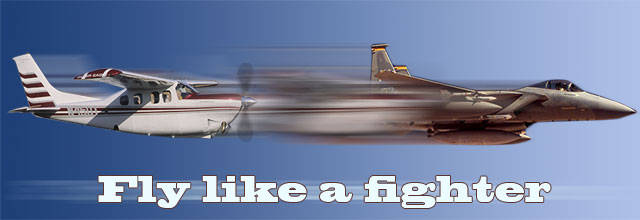
Dogfighting is really an extension of some basic formation maneuvering we learned in primary and advanced flight training with another cooperative aircraft. Using a building block approach we would learn how to stay in position, and regain position, through a variety of airspeeds, altitudes, and attitudes. We would initially brief power settings and airspeeds so the new student would have some reference to work with. From both the lead and wing, I learned how to assess the other jet’s flight parameters, which allowed me to predict what he could actually do or not do with his jet.
The most fundamental tool we used to compare maneuvering geometry was line of sight. If you were closing on another aircraft and they appeared to stay at the same point in your canopy, then you were on a collision course. If that point appeared to move behind you then you would end up in front of them, and vice versa if that point moved ahead of you.
 In a dogfight, the real challenge is that you are flying against an uncooperative jet who doesn’t necessarily want you to know his airspeed, energy state, or intentions. In addition, we practiced against different kinds of fighters that have different performance envelopes. Part of the fine art of winning a dogfight is figuring out your adversary’s airspeed so that you can outmaneuver him. Observing line of sight, whether you were on the offense or defense, was always our primary comparison tool.
In a dogfight, the real challenge is that you are flying against an uncooperative jet who doesn’t necessarily want you to know his airspeed, energy state, or intentions. In addition, we practiced against different kinds of fighters that have different performance envelopes. Part of the fine art of winning a dogfight is figuring out your adversary’s airspeed so that you can outmaneuver him. Observing line of sight, whether you were on the offense or defense, was always our primary comparison tool.
With the other jet in front of you, the F-15 radar would tell you his airspeed. If you were on the defensive looking at the other jet behind you, the task was a bit trickier. Line of sight didn’t always tell the whole story. A more difficult analysis included watching his nose track. If I was in a turn and his nose (and gun) was pointing behind me, and stayed behind me, then I knew I was generally OK. If his nose was able to pull through my turn and point at me, then I needed to do something different to get out of the way. The most subtle thing I learned to assess the other jet’s airspeed, at close range, was to observe how much his horizontal stabilizer (elevator) was deflected in his turn. Larger deflections meant a slower speed.
These concepts are still applicable in the general aviation world. Consider traffic pattern operations at a nontowered airfield. As a start, it is helpful to have a general vocabulary of the different types of airplanes around and a basic knowledge of their approach speeds, just like as an F-15 pilot I routinely studied the performance manuals of many different aircraft. Understanding line of sight will then be your primary tool to safely sequence yourself in, or break out from, the traffic pattern. Watch for relative motion to see if other traffic will pass in front of, behind, or on top of you.
One last tip: If you can see the deflection on someone else’s elevator in the pattern, you are way too close!
Larry Brown of Colorado Springs, Colo., is a retired Air Force F-15 pilot who is using the lessons he learned as a fighter pilot as a GA pilot in his Cessna P210. Brown, who has 2,600 hours total time during his 32 years of flying, also was an instructor pilot and flight examiner in the Air Force T-38 and instructor pilot in the T-52, the military’s version of GA’s Diamond DA40. See previous installments of “Fly like a fighter.”



